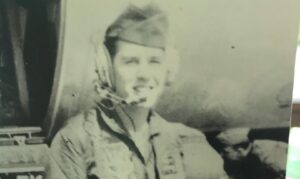When I was a child, from the time I was old enough to sit on the floor and play with my toes until far past the time I put on my first coat of mascara, I have loved records.
I thought it was magical that I could put a black round disc on my little phonograph player and soon music or words would be playing. This absolutely fascinated me.
If you ever run into Tink, ask him to show you one of his favorite photos. He always has it close at hand. My husband enjoys plundering through boxes of old things to find pieces of me as a little girl.
Somewhere, he found a black and white photo of a plump 3-year-old clutching an old 45 record in my pudgy fingers. My head is flung back joyously and I am laughing. In every photo from my childhood, I am either laughing merrily or grinning happily with twinkling eyes.
And, too, in most photos of a childish me, you can count on seeing a piece of my petticoat trimmed in lace.
“Why are you always showing off your petticoat in photos?” he asked, laughing as he gazed at the ensemble of white blouse with a Peter Pan collar, a jumper, lace-trimmed socks, and black patent shoes.
I shrugged. “I liked my petticoats. They made me feel pretty.”
Without fail, every photo – and Tink has a few of these he can share, too – I have bobbed red-brown hair with bangs that are too short and crooked. They are at least a half inch longer on one side that the other.
“And your bangs are always crooked.” He laughed again.
“Because Mama cut them and if she couldn’t find her regular scissors, she’d just use her pinking shears.” It’s a good thing that my happiness didn’t depend on me being pretty because those bangs were plenty ugly.
So, this child with crooked bangs, a happy personality and petticoats longer than her dresses, loved records. As soon as I could read, I was equally fascinated with the record jackets. Whenever I got a new one, I would sit down and read every word written on the back. In those days of vinyl records, it often included what was known as “liner notes” which were a couple of paragraphs about the album and sometimes included a story about the artist or the songs.
Faithfully, I read who produced the album, which musicians played on the session and, importantly, who wrote the songs. Sadly, this is something that has been lost to downloaded music and even CDs. Musicians and songwriters are rarely credited and these are the powerful punch behind any music.
Several years ago, I was having lunch with my friend, Don Light, in Nashville. In his early days, Don played drums on the Grand Ole Opry. This is aptly noted because drums were banned from the Opry until sometime in the 1960s. While we were lunching, a guy stopped by the table for a chat. After he walked off, Don said, “He’s one of the best session players in town.” He paused. “He’s played on every record that George Strait every made. For, I don’t know, 20 years or so.”
“That’s impressive.”
He leveled his blue eyes at me. “And he’s never met him.”
“What? All those records? All those number ones?”
“He told George’s producer the other day if the opportunity ever comes up, he sure would like to meet him.” He chuckled. “It’s overdubbing. The session players come in, do their thing, then the artist comes in later and lays down the vocal tracks. Gone are the days when everyone was in the same room together making music and records.”
What a shame. Instrumentalists and vocalists not recording together? And no credit to the songwriters and musicians?
The little girl with the petticoat showing and the crooked bangs wouldn’t like that near as much.
[Ronda Rich is the best-selling author of the new book, “Mark My Words: A Memoir of Mama.” Visit www.rondarich.com to sign for her free weekly newsletter.]









Leave a Comment
You must be logged in to post a comment.